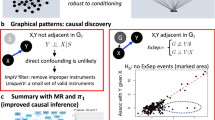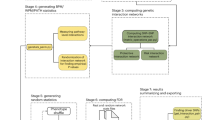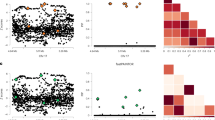Abstract
Epistatic interactions among multiple genetic variants in the human genome may be important in determining individual susceptibility to common diseases. Although some existing computational methods for identifying genetic interactions have been effective for small-scale studies, we here propose a method, denoted 'bayesian epistasis association mapping' (BEAM), for genome-wide case-control studies. BEAM treats the disease-associated markers and their interactions via a bayesian partitioning model and computes, via Markov chain Monte Carlo, the posterior probability that each marker set is associated with the disease. Testing this on an age-related macular degeneration genome-wide association data set, we demonstrate that the method is significantly more powerful than existing approaches and that genome-wide case-control epistasis mapping with many thousands of markers is both computationally and statistically feasible.
This is a preview of subscription content, access via your institution
Access options
Subscribe to this journal
Receive 12 print issues and online access
$209.00 per year
only $17.42 per issue
Buy this article
- Purchase on Springer Link
- Instant access to full article PDF
Prices may be subject to local taxes which are calculated during checkout





Similar content being viewed by others
References
Moore, J.H. & Williams, S.M. New strategies for identifying gene-gene interactions in hypertension. Ann. Med. 34, 88–95 (2002).
Ritchie, M.D. et al. Multifactor-dimensionality reduction reveals high-order interactions among estrogen-metabolism genes in sporadic breast cancer. Am. J. Hum. Genet. 69, 138–147 (2001).
Zee, R.Y. et al. Multi-locus interactions predict risk for post-PTCA restenosis: an approach to the genetic analysis of common complex disease. Pharmacogenomics J. 2, 197–201 (2002).
Williams, S.M. et al. Multilocus analysis of hypertension: a hierarchical approach. Hum. Hered. 57, 28–38 (2004).
Tsai, C.T. et al. Renin-angiotensin system gene polymorphisms and atrial fibrillation. Circulation 109, 1640–1646 (2004).
Cho, Y.M. et al. Multifactor-dimensionality reduction shows a two-locus interaction associated with Type 2 diabetes mellitus. Diabetologia 47, 549–554 (2004).
Nelson, M.R., Kardia, S.L., Ferrell, R.E. & Sing, C.F. A combinatorial partitioning method to identify multilocus genotypic partitions that predict quantitative trait variation. Genome Res. 11, 458–470 (2001).
Culverhouse, R., Klein, T. & Shannon, W. Detecting epistatic interactions contributing to quantitative traits. Genet. Epidemiol. 27, 141–152 (2004).
Cook, N.R., Zee, R.Y. & Ridker, P.M. Tree and spline based association analysis of gene-gene interaction models for ischemic stroke. Stat. Med. 23, 1439–1453 (2004).
Kooperberg, C. & Ruczinski, I. Identifying interaction SNPs using Monte Carlo logic regression. Genet. Epidemiol. 28, 157–170 (2005).
Zheng, T., Wang, H. & Lo, S.H. Backward genotype-trait association (BGTA) - based dissection of complex traits in case-control design. Hum. Hered. 62, 196–212 (2006).
Marchini, J., Donnelly, P. & Cardon, L.R. Genome-wide strategies for detecting multiple loci that influence complex diseases. Nat. Genet. 37, 413–417 (2005).
Klein, R.J. et al. Complement factor H polymorphism in age-related macular degeneration. Science 308, 385–389 (2005).
Culverhouse, R., Suarez, B.K., Lin, J. & Reich, T. A perspective on epistasis: limits of models displaying no main effect. Am. J. Hum. Genet. 70, 461–471 (2002).
Zondervan, K.T. & Cardon, L.R. The complex interplay among factors that influence allelic association. Nat. Rev. Genet. 5, 89–100 (2004).
Collins, A., Lonjou, C. & Morton, N.E. Genetic epidemiology of single-nucleotide polymorphism. Proc. Natl. Acad. Sci. USA 96, 15173–15177 (1999).
Kruglyak, L. Prospects for whole-genome linkage disequilibrium mapping of common disease genes. Nat. Genet. 22, 139–144 (1999).
Wang, W.Y.S., Barratt, B.J., Clayton, D.G. & Todd, J.A. Genome-wide association studies: theoretical and practical concerns. Nat. Rev. Genet. 6, 109–118 (2005).
Liu, J.S. Monte Carlo Strategies in Scientific Computing (Springer, New York, 2001).
Acknowledgements
This work was supported in part by US National Institutes of Health grant R01HG002518-06, US National Science Foundation grant DMS-0204674 and a grant from the National Science Foundation of China (10228102). We thank J. Hoh for providing us the AMD data set and T. Niu for discussions.
Author information
Authors and Affiliations
Contributions
Y.Z. and J.S.L. designed the statistical models and simulation studies together. Y.Z. implemented the method and wrote the software. Both authors contributed to the writing of the manuscript.
Corresponding author
Ethics declarations
Competing interests
The authors declare no competing financial interests.
Supplementary information
Supplementary Text and Figures
Supplementary Methods, Supplementary Figures 1–4, Supplementary Table 1 (PDF 367 kb)
Rights and permissions
About this article
Cite this article
Zhang, Y., Liu, J. Bayesian inference of epistatic interactions in case-control studies. Nat Genet 39, 1167–1173 (2007). https://doi.org/10.1038/ng2110
Received:
Accepted:
Published:
Issue Date:
DOI: https://doi.org/10.1038/ng2110
This article is cited by
-
MTHSA-DHEI: multitasking harmony search algorithm for detecting high-order SNP epistatic interactions
Complex & Intelligent Systems (2023)
-
Concurrent outcomes from multiple approaches of epistasis analysis for human body mass index associated loci provide insights into obesity biology
Scientific Reports (2022)
-
Detecting genetic epistasis by differential departure from independence
Molecular Genetics and Genomics (2022)
-
A Novel Multitasking Ant Colony Optimization Method for Detecting Multiorder SNP Interactions
Interdisciplinary Sciences: Computational Life Sciences (2022)
-
GEP-EpiSeeker: a gene expression programming-based method for epistatic interaction detection in genome-wide association studies
BMC Genomics (2021)



